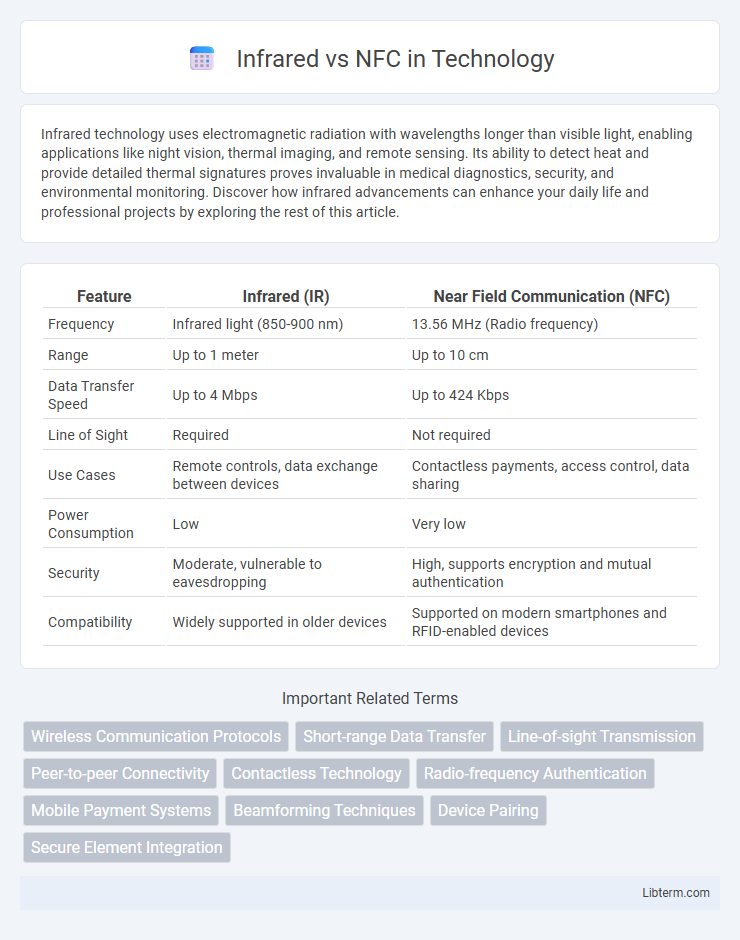Infrared technology uses electromagnetic radiation with wavelengths longer than visible light, enabling applications like night vision, thermal imaging, and remote sensing. Its ability to detect heat and provide detailed thermal signatures proves invaluable in medical diagnostics, security, and environmental monitoring. Discover how infrared advancements can enhance your daily life and professional projects by exploring the rest of this article.
Table of Comparison
| Feature | Infrared (IR) | Near Field Communication (NFC) |
|---|---|---|
| Frequency | Infrared light (850-900 nm) | 13.56 MHz (Radio frequency) |
| Range | Up to 1 meter | Up to 10 cm |
| Data Transfer Speed | Up to 4 Mbps | Up to 424 Kbps |
| Line of Sight | Required | Not required |
| Use Cases | Remote controls, data exchange between devices | Contactless payments, access control, data sharing |
| Power Consumption | Low | Very low |
| Security | Moderate, vulnerable to eavesdropping | High, supports encryption and mutual authentication |
| Compatibility | Widely supported in older devices | Supported on modern smartphones and RFID-enabled devices |
Introduction to Infrared and NFC
Infrared (IR) technology uses light waves in the infrared spectrum to enable short-range, line-of-sight communication between devices, commonly found in remote controls and some data transfer applications. Near Field Communication (NFC) operates through radio frequency electromagnetic fields, allowing secure, contactless communication within a few centimeters, widely used in mobile payments and access control. Both technologies facilitate wireless data exchange but differ significantly in range, security, and use cases.
How Infrared Technology Works
Infrared technology operates by transmitting data through infrared light waves, which are a type of electromagnetic radiation with wavelengths longer than visible light but shorter than radio waves. Devices using infrared communication must be aligned within the direct line of sight, as the signals cannot penetrate solid objects or walls, making it ideal for short-range, point-to-point data exchange. The technology relies on modulated infrared light pulses to encode information, which a receiver then decodes back into digital data, commonly used in remote controls and some consumer electronics.
How NFC Technology Works
NFC technology operates through electromagnetic radio fields at 13.56 MHz to enable short-range communication between devices within a few centimeters. It uses inductive coupling between two loop antennas, allowing data exchange through magnetic field induction without the need for a direct line of sight. Unlike infrared, which relies on light signals, NFC uses this magnetic induction to facilitate secure, contactless transactions and data sharing efficiently.
Key Differences Between Infrared and NFC
Infrared (IR) uses light waves to transmit data over short distances, requiring direct line-of-sight communication, while NFC (Near Field Communication) employs radio waves to enable secure, contactless data transfer within a few centimeters without line-of-sight. Infrared is commonly used in remote controls and requires precise alignment, whereas NFC is integrated into smartphones and contactless payment systems for seamless, quick interactions. The data transfer speed in NFC typically ranges from 106 kbps to 424 kbps, surpassing most IR implementations, which generally offer slower speeds.
Speed and Efficiency Comparison
Infrared (IR) communication typically offers data transfer speeds up to 4 Mbps, while Near Field Communication (NFC) operates at a maximum speed of 424 kbps, making IR faster for high-speed data exchange. However, NFC provides greater efficiency in short-range secure transactions by requiring minimal power and enabling quick device pairing within 4 cm proximity. The energy consumption of IR is generally higher due to its line-of-sight dependence, whereas NFC's efficiency is enhanced by its non-line-of-sight capability and simplified handshake protocols.
Security Features: Infrared vs NFC
Infrared technology transmits data via line-of-sight infrared light, making it vulnerable to interception and eavesdropping without encryption. Near Field Communication (NFC) employs close-range radio frequency signals with advanced encryption protocols and mutual authentication, significantly enhancing transaction security. NFC's secure element and tokenization methods provide robust protection against cloning and unauthorized access compared to infrared's basic transmission capabilities.
Range and Connectivity Limitations
Infrared (IR) technology operates within a very short range, typically up to 1 meter, requiring direct line-of-sight between devices, which limits its connectivity in obstructed environments. Near Field Communication (NFC) has a slightly shorter range, usually around 4 centimeters, but it enables secure, touch-based interactions without the need for alignment. Both IR and NFC have limitations in range, but NFC's ease of use and enhanced security make it more suitable for contactless payments and access control despite its proximity constraints.
Common Uses of Infrared Technology
Infrared technology is commonly used for remote controls in consumer electronics, allowing devices like TVs and air conditioners to communicate wirelessly over short distances. It is also used in optical data transmission systems and sensor technologies, including motion detectors and proximity sensors. Unlike NFC, infrared does not support data exchange through touchpoint interaction but excels in line-of-sight communication and device control.
Popular Applications of NFC Technology
NFC technology powers popular applications such as contactless payments, access control systems, and smart ticketing due to its secure and fast data exchange capabilities within close proximity. Unlike infrared, which requires line-of-sight communication, NFC enables seamless interactions in mobile wallets, public transport card systems, and digital identity verification. The widespread adoption of NFC in smartphones and wearables enhances convenience and supports emerging trends in IoT connectivity and secure authentication.
Which Is Better: Infrared or NFC?
Infrared (IR) and Near Field Communication (NFC) serve distinct purposes in wireless communication, with NFC offering superior convenience and security for data exchange over short distances, typically within 4 cm. Infrared requires direct line-of-sight and is limited by slower data transfer rates, making it less practical for modern applications like mobile payments and contactless authentication. NFC's compatibility with smartphones and enhanced encryption protocols make it the better choice for seamless, secure, and efficient device communication.
Infrared Infographic

 libterm.com
libterm.com